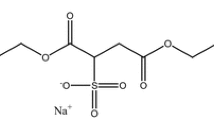Abstract
The paper concerns the chemists way of looking at evolution. It is not based on the DNA but on the chemical elements in The Periodic Table of Mendelev. The first step is the analysis of the element content of organisms as they arose historically. This shows that in keeping with our knowledge of the environment the chemical elements in organisms changed due to the rise in oxygen in the atmosphere. Elements such as copper and zinc were greatly increased in later organism as they were released from their sulfidic ores to the sea. The nature of the changes in the chemical elements available to organisms is then discussed in terms of their functions. It is shown that much though the Darwin perception of evolution is pure chance it is strictly guided by the inevitable chemistry of the elements arising from oxidation of the environment.













Similar content being viewed by others
References
Alon U (2006) An introduction to systems biology. Chapman and Hall/CRC, London
Carafoli E, Klee C (1999) Calcium as a cell regulator. Oxford University Press, New York
Castling D (2005) A chemical approach to evolution. Science 308:1730–1731
Cavalier-Smith T, Brasier M, Embley TM (ed) (2006) Major steps in cell evolution. Philos Trans Roy Soc B 361:843–1083
Corning PA (2001) Control information. Kybernetes 30:1272–1288
Darwin C (1859) On the origin of species by natural selection. J. Murray, London
Dupont CL, Yang S, Palenik B, Bourne PE (2006) Proc Natl Acad (USA) 103:17822–17827
Fraústo da Silva JJR, Williams RJP (2001) The biological chemistry of the elements. Oxford University Press, Oxford and see references
Harold F (2001) The way of the cell. Oxford University Press, New York
Janlonka E, Lamb M (1995) Epigenetic inheritance and evolution. Oxford University Press, New York
Leach S, Smith I, Cockell C (ed) (2006) Conditions for emergence on Earth of early life. Phil Trans Roy Soc B 361:1675–1894
Lovelock J (2000) Homage to Gaia. Oxford University Press, Oxford
Margulis L (1998) Symbiotic planet. Basic Books, New York
Maynard-Smith J, Szathmáry E (2000) The origins of life—from the birth of life to the origins of language. Oxford University Press, Oxford
Morgan R, Martin-Almedina S, Gonzalus MI, Ferdinanez MP (2004). Biochim Biophys Acta 1742:133–140
Neuberger MS, Harris RS, Di Noia JM, Petersen-Mahrt SK (2003) Immunity through DNA deamination. Trends Biochem Sci 28:305–312
Outten CE, O’Halloran TV (2001) Femtomolar sensitivity of metalloregulatory proteins. Science 292:2488–2492
Saito MA, Sigma DM, Morel FMM (2003) The biochemical cycles of the ancient ocean. Inorg Chim Acta 356:308–320
Thauer RK, Shima S (2006) Biogeochemistry, methane and microbes. Nature 440:878–879
Wachtershauer G (1988) Origins of life and iron sulfides. Microbiol Rev 52:482–486
Weber BH, Prebble JN (2006) An issue of originality and priority: the correspondence and theories of oxidative phosphorylation of Peter Mitchell and Robert J.P. Williams, 1961–1980. J Hist Biol 39:125–163
Williams RJP (1961) Functions of chains of catalysts. J Theoret Biol 1:1–13
Williams RJP, Fraústo da Silva JJR (2006) The chemistry of evolution. Elsevier, Amsterdam and see references
Woese CR (1998) The universal ancestor. Natl Acad Sci USA 95:6854–6859
Acknowledgments
This paper is in very large part a reproduction of a paper, R.J.P. Williams, A Chemical Systems Approach to Evolution, Dalton Transactions 2007, 991–1001, with permission from The Royal Society of Chemistry, UK.
Author information
Authors and Affiliations
Corresponding author
Additional information
Note
Since the material in this survey was published in Maynard-Smith and Szathmáry (2000) and Williams and Fraústo da Silva (2006) several authors have analysed DNA/RNA sequences in greater detail, see C. Andreini, L. Banci, I. Bertini and A. Rosato. J. Proteome Res. 2006, 5, 3173–3178, J.W. Torrance, M.W. MacArthur and J.M. Thornton, Structure, Function and Bio-information, 71, 813–830, 2008, and Y. Zhang and V.N. Gladyshev. Chem. Rev. 2009 (May) and the references in these articles. The conclusions strongly re-enforce the connection we have described in this article and previously between the environment changes and the evolution of organisms which has to be via inorganic chemistry changes, principally oxidation.
Note Concerning this Paper
This paper was given on 29th May 2009 at a meeting of the Accademia Nazionale dei Lincei in order to celebrate the 140th anniversary of the formulation of The Periodic Table by Mendelev. The paper does not concern the chemistry of all the elements in that table but refers only to those of significance in living organisms. However, the functional significance of the elements involved in living processes is a direct reflection of their properties as placed in that table. There are the very different values of the elements in Group I, Na and K; Group II, Mg and Ca; transition metals in Groups III to XI from Sc to Cu; B-subgroup elements such as Zn in Group XII and non-metals from Groups XIII to XVII including B, C, N, O, Cl, Si, P, S, Se and I but as in Mendelev’s original table the elements of Group XVIII, the noble gases, do not appear. It is not only mineral but also biological inorganic chemistry that is systematized in the table. Evolution of the environment and organisms are closely related to the inorganic chemistry Mendelev’s Table reflects.
Rights and permissions
About this article
Cite this article
Williams, R.J.P. A chemical systems approach to evolution. Rend. Fis. Acc. Lincei 21, 47–70 (2010). https://doi.org/10.1007/s12210-009-0053-9
Received:
Accepted:
Published:
Issue Date:
DOI: https://doi.org/10.1007/s12210-009-0053-9




